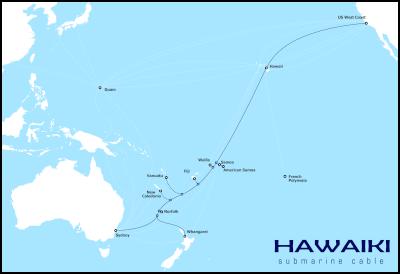Big opportunities for Northland in undersea cable deal
Big opportunities for Northland in undersea cable deal with Hawaiki

Auckland, Monday, 29 July
2013 – Northland is poised to score a major technological
and economic coup with the signing of a deal that could see
the New Zealand link of a proposed international submarine
cable project worth hundreds of millions coming ashore in
Whangarei.
New Zealand-based Pacific submarine cable
developer and owner Hawaiki Cable Limited is planning to
build a $US350M submarine cable system to carry vast
quantities of electronic data between Australia, New
Zealand, Hawaii and the west coast of the United
States.
The cable could be operating within as little as two years and will be the second fibre optic cable network linking New Zealand with the rest of the world, bringing true competition to the market and providing security of supply necessary for the country to host international data centres.
In what is being described as a huge coup for the North, Hawaiki has signed a Memorandum of Understanding with regional economic development agency Northland Inc to land the new cable in the Whangarei area.
Under the agreement, Hawaiki commits to bring its cable ashore in the Whangarei area and build associated land-based infrastructure (including its cable landing station) in Northland.
Northland Inc will aid both the landing and the funding of the cable, including sourcing local investors and promoting funding through the Northland Regional Council’s Investment and Growth Reserve. The agency will also facilitate consents and permits required to land the cable, including the necessary addition to the east coast’s undersea Cable Protection Area.
Hawaiki Cable Limited
CEO Rémi Galasso says the system, which has a design life
of 25 years, will be based on 100 Gigabits per second (Gbps)
wavelength technology and deliver more than 20 Terabits per
second (Tbps) of design capacity.
That's enough speed
to send about 468 DVDs in one single second, and it is hoped
that as well as accelerating the development of a
potentially lucrative data centre industry in this country,
it will also ultimately lead to much cheaper Internet access
for end-users.
Mr Galasso says the way the system has
been designed means it will also have the option to connect
to the main trunk a number of Pacific Islands located next
to the cable route, including Norfolk, New Caledonia,
Vanuatu, Fiji, Wallis, Samoa and American
Samoa.
Northland Inc Chairman Colin Mitten says the
MoU has been under discussion for almost six months and
while its finer points have still to be negotiated,
construction of the Hawaiki submarine cable would mark a
critical milestone for both Northland and New Zealand’s
economy.
“This MoU has the potential to bring direct
and indirect benefits worth millions to Northland’s local
economy alone,” says Mitten. “Our plan is to develop
information and communication technologies (ICT) to
substantially strengthen Northland’s economy, which is
currently based on the primary sector industries, as well as
create new job opportunities.
“With the Hawaiki
cable landing in Whangarei, we will be able to propose very
competitive solutions for local and foreign investors,
willing to benefit from our green power, ICT infrastructure,
stable economy, climate and world class
environment.”
Mr Galasso says the Hawaiki cable
would remove the sole remaining barrier to the development
of a data centre industry in this country and complement the
existing cables its competitors owned, which land in the
Auckland area.
“We very much believe in the
potential of New Zealand for ICT,” he says. “All the
ingredients necessary for the development of a datacentre
industry, including political stability, a temperate
climate, green power and educated workforce are already
available here. The missing link is submarine cable
diversity with a direct access to the United
States.”
He says three conditions governed the
selection of the Hawaiki cable New Zealand landing
site:
• A different location from existing submarine
cables to protect security of supply in the event of natural
disaster, like an earthquake or other unforeseen
event
•
• Access to existing land-based data
transfer networks
•
• Availability of green power
for future development
•
•
“Whangarei
scored the highest in all categories and made the decision
easy. On top of that, I believe Northland Inc’s strategy
for the economic development of the region is remarkable.
Its plan to co-invest in Hawaiki clearly demonstrates that
Northland is building for the future generation,” says
Galasso.
The MoU signatories expect to finalise
definitive agreements within the next few months and see the
cable operational by autumn
2015.
Ends


 WorkSafe NZ: Worker’s Six-Metre Fall Prompts Industry Call-Out
WorkSafe NZ: Worker’s Six-Metre Fall Prompts Industry Call-Out PSGR: Has MBIE Short-Circuited Good Process In Recent Government Reforms?
PSGR: Has MBIE Short-Circuited Good Process In Recent Government Reforms? The Reserve Bank of New Zealand: RBNZ’s Five Year Funding Agreement Published
The Reserve Bank of New Zealand: RBNZ’s Five Year Funding Agreement Published Lodg: Veteran Founders Disrupting Sole-Trader Accounting in NZ
Lodg: Veteran Founders Disrupting Sole-Trader Accounting in NZ New Zealand Airports Association: Airports Welcome Tourism Marketing Turbocharge
New Zealand Airports Association: Airports Welcome Tourism Marketing Turbocharge Ipsos: New Zealanders Are Still Finding It Tough Financially; Little Reprieve Expected In The Next 12 Months
Ipsos: New Zealanders Are Still Finding It Tough Financially; Little Reprieve Expected In The Next 12 Months



